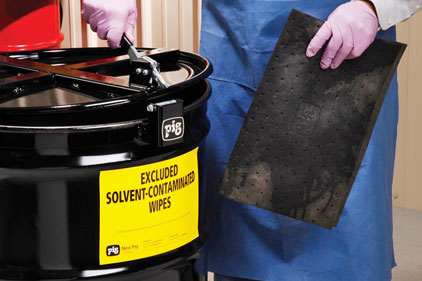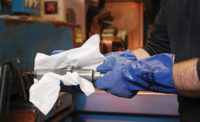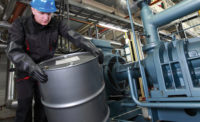The rule became effective at the federal level on January 31, 2014, and is currently in effect in seven states and three territories. Many other states are currently working on adoption of the rule.
Wipes
Under the new rule, a wipe is broadly defined as, “a shop towel, rag, pad or swab made of wood pulp, fabric, cotton, polyester blends, or other material” [40 CFR 260.10]. The definition clarifies that wipes have multiple shapes and different uses, including traditional surface wiping and spill cleanup.
Not all wipes are eligible for exemption. The exemptions are limited to disposable and reusable wipes that:
• Are contaminated with F001-F005 listed solvents [40 CFR 261.31] or corresponding P- or U-listed solvents [40 CFR 261.33], or
• Exhibit a hazardous characteristic resulting from a solvent listed in 40 CFR 261, or
• Exhibit only the hazardous characteristic of ignitability when containing one or more non-listed solvents.
Wipes that are saturated with listed hazardous wastes other than solvents, or that have the characteristics of toxicity, corrosivity or reactivity may not be managed as solvent-contaminated wipes.
Disposable and reusable wipes
Although wipes come in many shapes and sizes, they can be grouped into two categories. Disposable solvent-contaminated wipes are wipes that are properly managed while they are onsite, and will be appropriately landfilled or sent to a combustor after use. When these conditions are met, the wipes are not hazardous waste [40 CFR 261.4(b)(18)].
Reusable solvent-contaminated wipes are wipes that will be laundered or dry-cleaned at a permitted cleaning establishment and returned to facilities for reuse. These wipes, when properly managed, are excluded from solid waste regulation [40 CFR 261.4(a)(26)].
Wipe management
Solvent-contaminated wipes — both disposable and reusable — must be managed properly throughout their life cycle, including laundering, combustion and/or disposal. The management requirements are designed to minimize the potential for leaks or discharges that could cause environmental harm.
Spent wipes contaminated with solvents must be kept in non-leaking, closed containers. Drums, cans, bags or other devices may be used to collect the spent wipes at a generator’s location, as long as there is complete contact around the rim or top of the container. The container must also be capable of containing free liquids.
In addition to minimizing the chance for leaks, closed containers help to reduce the risk of fires and minimize fugitive emissions. Containers must be labeled “Excluded Solvent-Contaminated Wipes” to help prevent mixing of waste streams.
Free liquids
To avoid containers full of liquid solvent waste from being managed and handled under this exemption, solvent-contaminated wipes cannot contain any free liquids when they are being sent off-site for laundering, combustion or disposal. Any free liquids must be managed appropriately as hazardous waste.
Removing free liquids from wipes reduces the potential for leaks and spills, especially at handling and disposal facilities. This can be accomplished by storing the wipes in a container with a mesh-screened bottom that allows free liquids to drain, mechanically wringing, centrifuging, vacuum extracting or using any other equivalent means to ensure that no liquids will leak or drip from the wipe. Any free liquids that are removed from the wipes are not eligible for exemption.
To meet the no free liquids criteria, each wipe must be able to pass the EPA Paint Filter Test (Methods Test 9095B).This test was chosen because many states and municipal solid waste landfills already use this test to determine if certain materials can be landfilled. Not every wipe needs to be tested. However, the generator must ensure that if each wipe was tested, it would pass the test.
Accumulation time limits
Solvent-contaminated wipes may be accumulated for up to 180 days before being sent for laundering, combustion or disposal. This time limit ensures that free liquids are removed from collection containers and properly managed, and that wastes are not being accumulated indefinitely.
The accumulation start date must be marked on collection containers to prevent wipes from being stored past the accumulation deadlines. The start date is the day that the first wipe is placed in the container.
Handling and documentation
Launderers, dry cleaners, combustors and landfills that handle solvent-contaminated wipes must be properly permitted and follow applicable Clean Water Act, Clean Air Act and/or RCRA regulations pertaining to their operations. By requiring wipes to be handled at properly permitted facilities, the risk of solvents being released to the air, water or soil is minimized.
Generators have the liberty of choosing which handling methods to use for their wipes. They must also maintain documentation to ensure that solvent-contaminated wipes are being managed properly while they are onsite, and that they have been sent for appropriate laundering, recycling or disposal.
Documentation must include the name and address of the wipe-handing facility, a description of the process being used to meet the no free liquids condition and verification that the 180-day accumulation limit is not being exceeded. Generators can use invoices to help satisfy the 180-day accumulation documentation requirement.
According to Mathy Stanislaus, EPA assistant administrator for solid waste and emergency response, this rule “reduces costs for thousands of businesses, many of which are small businesses, while maintaining protection of human health and the environment.” It also resolves many of the management and handling discrepancies between reusable and disposable wipes, helping to even the playing field and enabling facilities to use the best type of product for their application.


